Fauna 2021
Title:: Fauna
Date of Issue: 20.05.2021.
Author: Tanja Kuruzovic
Type edition: commemorative
Printing techniques: multicolour offset
Sheet: 4х2
Paper: muflep 100g
Printing House: Blicdruk, Sarajevo
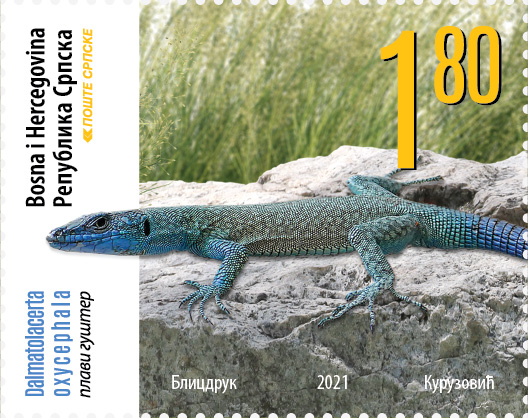 Motive: blue lizzard
Motive: blue lizzard
Catalogue no.: 869
Perforation: 13 3/4
Face value: 1.80 BAM
Quantity: 15 000
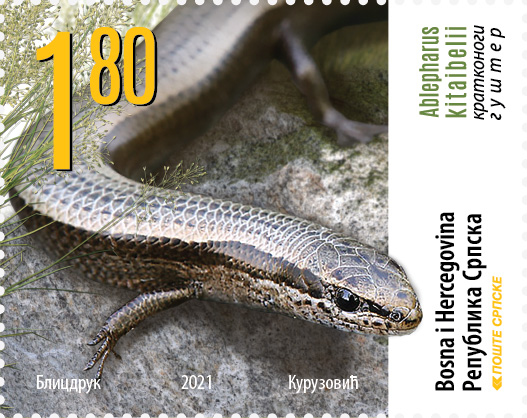
Motive: short-legged lizard
Catalogue no.: 870
Perforation: 13 3/4
Face value: 1.80 BAM
Quantity: 15 000
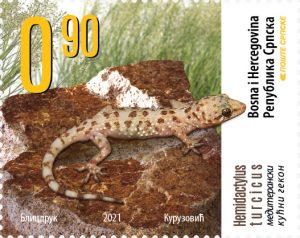 Motive: Mediterranean house gecko
Motive: Mediterranean house gecko
Catalogue no.: 871
Perforation: 13 3/4
Face value: 0,90 BAM
Quantity: 15 000
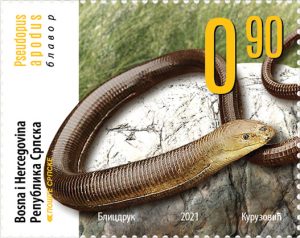 Motive: European legless lizard
Motive: European legless lizard
Catalogue no.: 872
Perforation: 13 3/4
Face value: 0,90 BAM
Quantity: 15 000
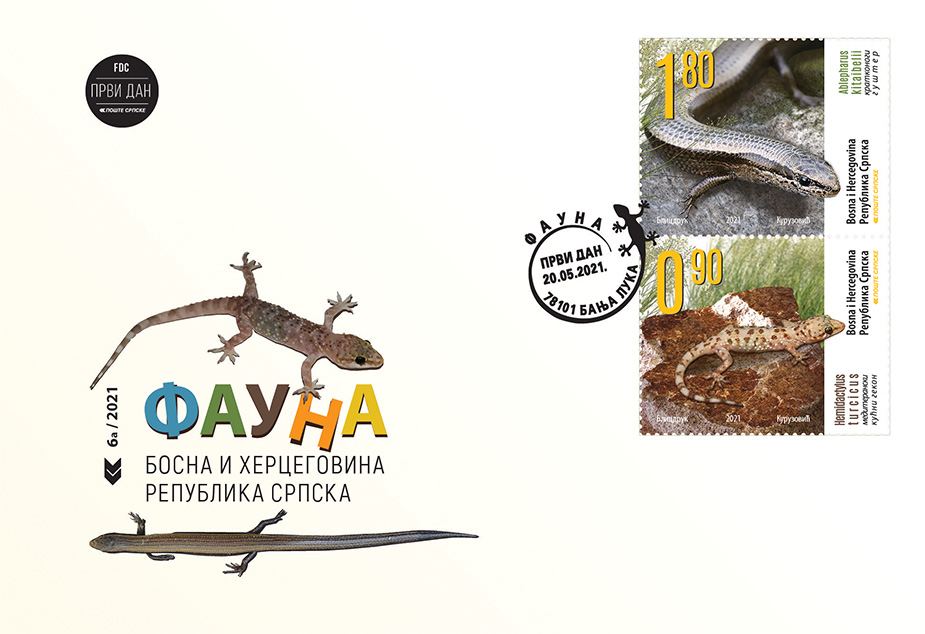
Bosnia and Herzegovina is rich in high diversity of plant and animal species, ecosystems and genetic diversity among species, due to its specific geographical location and pronounced different climatic zones from north to south. It is characterized by a large number of refugiums and habitats that favored the conservation of species during the last ice age, which began in Europe 2.6 million years ago and lasted until 11,700 years ago. In Bosnia and Herzegovina, 29 indigenous species of reptiles have been registered, and there are two other registered non-indigenous species of turtles originating from America and Asia.
Ablepharus kitaibelii Bibron & Bory de Saint-Vincent, 1833 – short-legged lizard
Ablepharus kitaibelii or short-legged lizard inhabits southeastern Europe, western and central Turkey. It is the rarest reptile in Bosnia and Herzegovina and was found only in the area of eastern Bosnia and Herzegovina, near Ustikolina.
The short-legged lizard grows up to 15 cm. Their eyelids are immobile which distinguishes them from other lizards in this area. Females are larger than males. It is copper brown to a shiny olive-green color, with darker sides. Males are usually darker than females.
It inhabits dry areas, including the slopes of the southern exposure, meadows, thickets and clearings in the forest. It is usually located near the ground cover such as leaves, dead trees, stones, shrubs and other vegetation.
It is a strictly protected species according to the Decree on protected and strictly protected wild species of the Republic of Srpska.
Hemidactylus turcicus Linnaeus, 1758 – Mediterranean house gecko
Hemidactylus turcicus or Mediterranean house gecko is widespread around the Mediterranean basin and in western Asia. It is also found in certain parts of continental Europe and on numerous islands in the Mediterranean. In Bosnia and Herzegovina, this species has been recorded in the Mediterranean area, from Ljubuski through Capljina and Mostar, across Popovo polje to the foot of Mount Orjen.
Sizes are about 10 cm and sometimes longer. They are very agile and active animals, especially at night. They have sticky surfaces on the toes, and each finger ends in a claw. They are often pale and pink-colored skin, covered with scales resembling warts. They have dark, irregular spots on their backs. They have the ability to change body color, relative to habitat color. Their eyes are large, with elongated vertical pupils.
They inhabit warmer, coastal areas. They are sometimes widespread in the interior of the continent along river valleys. It is an extremely adaptable species and inhabits rocky areas, coastal areas, cliffs, caves, and is common in urban areas.
Due to its distribution and adaptability, the species is not included in the Decree on Protected and Strictly Protected Wild Species of the Republika Srpska.
Author: Tanja Kuruzovic
Cooperation: Ana Curic, senior expert associate for biodiversity - zoologist, Republic Institute for Protection of Cultural and Natural Heritage of Republic of Srpska
Publisher: Poste Srpske a.d. Banjaluka
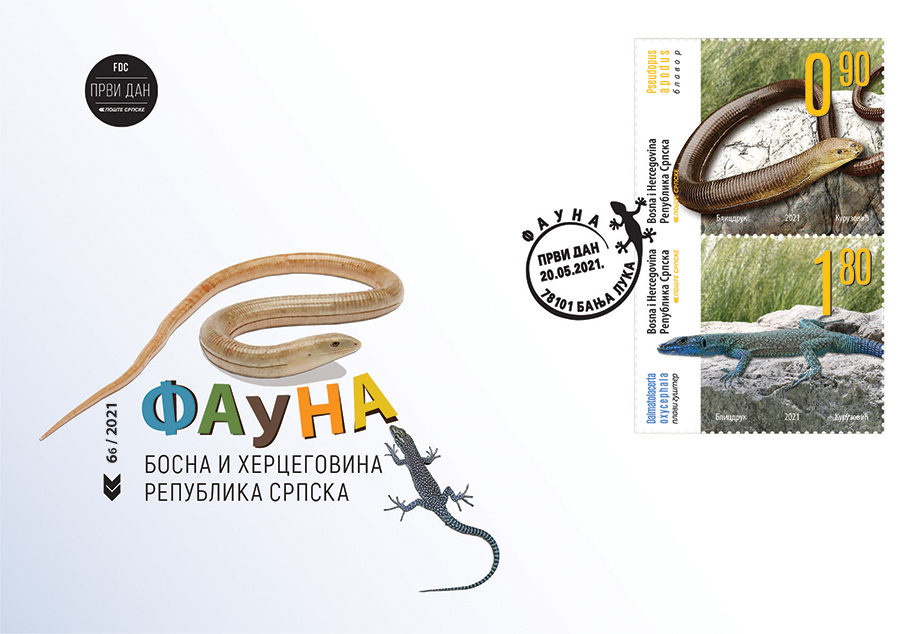
Bosnia and Herzegovina is rich in high diversity of plant and animal species, ecosystems and genetic diversity among species, due to its specific geographical location and pronounced different climatic zones from north to south. It is characterized by a large number of refugiums and habitats that favored the conservation of species during the last ice age, which began in Europe 2.6 million years ago and lasted until 11,700 years ago. In Bosnia and Herzegovina, 29 indigenous species of reptiles have been registered, and there are two other registered non-indigenous species of turtles originating from America and Asia.
Pseudopus apodus Pallas, 1775 - European legless lizard
Pseudopus apodus Pseudopus apodus better known as a European legless lizard is a widespread species in western Eurasia. It can be found in the southern part of Bosnia and Herzegovina, the coastal part of Croatia, Montenegro, Northern Macedonia, Albania, Greece.
European legless lizard can grow up to 140 cm, and the tail can reach 2/3 of the total body length. It is the largest lizard in Bosnia and Herzegovina. It is yellowish-brown in color. Some individuals often have stunted remnants of hind legs that are not even noticeable in most. Adult individuals are generally uniformly colored while the cubs are grayish with a pronounced dark pattern, and somewhat reminiscent of venomous snakes which plays a role in their mimicry and survival. European legless lizard is very mobile, regardless of his size and stunted limbs.
They live in very dry habitats, mostly on rocky slopes with little vegetation, in deciduous forests and rocky walls, and can be found in cultivated areas and near human settlements. They are active both day and night but avoid high daytime temperatures.
The species is protected according to the Decree on protected and strictly protected species of the Republic of Srpska.
Dalmatolacerta oxycephala Dumeril & Bibron, 1839 – blue lizard
Dalmatolacerta oxycephala or blue lizard is present in Mediterranean and sub-Mediterranean habitats in southern Croatia (including some Adriatic islands), southern Bosnia and Herzegovina and Montenegro. In Bosnia and Herzegovina, it was recorded west of Livanjsko field, across the whole of Herzegovina to the Maglic mountain in the east, and north through the Neretva canyon to the Ljuta canyon in Treskavica.
Distinctly from front to back flattened, smaller lizard with an elongated head with a pointed snout and noticeably raised eyes, up to about 18 cm long. The coloration varies from gray through faint green, intense light blue to indefinitely dark. Some individuals may change color throughout the year by becoming darker in colder conditions. The underside is blue, more intensely colored in males and dark individuals.
The blue lizard loves the sun and usually inhabits rocky areas, cliffs and walls. They are very resistant to cold and can sometimes be seen in the mountains while there is still snow cover.
Based on existing data, the species is protected under the Regulation on Strictly Protected and Protected Wild Species in the Republic of Srpska.
Author: Tanja Kuruzovic
Cooperation: Ana Curic, senior expert associate for biodiversity - zoologist, Republic Institute for Protection of Cultural and Natural Heritage of Republic of Srpska
Publisher: Poste Srpske a.d. Banjaluka



